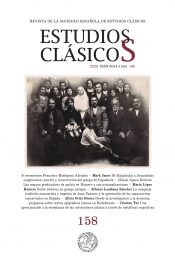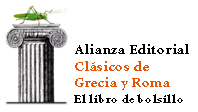SOBRE ΟΠΟΣΤΟΣ EN GRIEGO ANTIGUOOn οποστος in Ancient Greek
María López Romero
Universidad de Sevilla
http://us.academia.edu/Mar%C3%ADaLópezRomero
https://www.us.es/trabaja-en-la-us/directorio/maria-lopez-romero
Resumen
Casi la totalidad de las gramáticas de referencia del griego antiguo ha desatendido el adjetivo pronominal ὁπόστος. Este hecho quizá se explique por su escasa atestiguación en la literatura conservada, aparentemente a causa de su alto nivel de especialización semántica («el número u orden que»). Así las cosas, pretendemos analizar todos los ejemplos disponibles para, en primer lugar, identificar las funciones sintácticas de ὁπόστος y, en segundo lugar, intentar trazar la conexión que existe entre ellas. El análisis ha revelado que ὁπόστος tiene tres usos, a saber, indefinido, relativo e interrogativo indirecto. Su morfología sugiere que el uso como interrogativo es el más antiguo, aunque sea el menos documentado. En efecto, ὁπόστος sigue el patrón de formación de los pronombres interrogativos indirectos (sc. relativo fosilizado ὁ + interrogativo directo). El uso como relativo pudo haber surgido en contextos donde más de una interpretación era estructuralmente posible, sobre todo en dependencia de verbos de lengua, percepción y conocimiento. Por último, el uso como indefinido deriva probablemente de oraciones de relativo genéricas con el verbo elíptico.
Palabras clave: ὁπόστος; interrogativa indirecta; oración de relativo; pronombre indefinido
Abstract
The pronominal adjective ὁπόστος has been disregarded by most reference grammars of Ancient Greek. This fact could be explained by its scarce attestation in the extant literature, presumably due to its high level of semantic specialization («in what or which place in numerical order»). Therefore, this paper aims to analyse all the evidence available in order, first, to identify the syntactic functions of ὁπόστος and, second, to try to trace the link between them. The analysis has revealed three uses of ὁπόστος, namely, as an indefinite, as a relative and as an indirect interrogative. Its morphology suggests that the use as an interrogative is the original, despite being the less attested. In effect, ὁπόστος follows the pattern of formation of indirect interrogative pronouns (sc. frozen ὁ plus a direct interrogative pronoun). The use as a relative could have emerged from contexts where more than one interpretation was structurally possible, mostly on dependence of utterance, perception and cognition verbs. Lastly, the use as an indefinite probably derives from generic relative clauses with elliptical verb.
Keywords: ὁπόστος; indirect question; relative clause; indefinite pronoun
Referencias bibliográficas
Adrados, F. (1992) Nueva sintaxis del griego antiguo, Madrid, Gredos.
Allen, T. W. (19902) Homeri opera, vol. 4, Oxford, Oxford University Press.
Basile, N. (1998) Sintassi storica del greco antico, Bari, Levante Editori.
Beekes, R. (2010) s.v. «πόσος», Etymological Dictionary of Greek, vol. 2, Leiden/Boston, Brill, 1225.
Chantraine, P. (1974) s.v. «πο-», Dictionnaire étymologique de la langue grecque. Histoire des mots, vol. 3, París, Klincksieck, 921-922.
— (19842) Morphologie historique du grec, París, Klincksieck.
Crespo, E., Maquieira, H. & Conti, L. (2003) Sintaxis del griego clásico, Madrid, Gredos.
Denniston, J.D. (19542) The Greek Particles, Oxford, Oxford at the Clarendon Press.
Dik, S.C. (1997) The Theory of Functional Grammar. Part 2: Complex and Derived Constructions, Berlín/Nueva York, Mouton de Gruyter.
Dryer, M.S. (2013) «Order of Relative Clause and Noun», en M.S. Dryer & M. Haspelmath (eds.) The World Atlas of Language Structures Online, Leipzig, Max Planck Institute for Evolutionary Anthropology. URL: https://wals.info/chapter/90 {09/10/2020}.
Emde Boas, E. van, Rijksbaron, A., Huitink, L. & Bakker, M. de (2019) The Cambridge Grammar of Classical Greek, Cambridge, Cambridge University Press.
Esseesy, M. (2009) «Semantic Extension», en M. Eid, A. Elgibali, M. Woidich & A. Zaborski (eds.) Encyclopedia of Arabic Language and Linguistics, Leiden/Boston, Brill, 164-169.
Fauconnier, S. (2014) «Internal and External Relative Clauses in Ancient Greek», JGL 14, 141-162, DOI: 10.1163/15699846-01402001.
Givón, T. (2009) The Genesis of Syntactic Complexity, Ámsterdam/Filadelfia, John Benjamins.
Goodwin, W.W. (1900) Greek Grammar, Boston, Ginn & Company.
Heine, B. & Kuteva, T. (2002) World Lexicon of Grammaticalization, Cambridge, Cambridge University Press.
— (2007) The Genesis of Grammar. A Reconstruction, Oxford, Oxford University Press.
Hendery, R. (2012) Relative Clauses in Time and Space, Ámsterdam/Filadelfia, John Benjamins.
Horrocks, G. (20102) Greek. A History of the Language and its Speakers, Malden, Wiley-Blackwell.
Humbert, J. (19603) Syntaxe grecque, París, Klincksieck.
Jiménez López, M.D. (2006) «Las oraciones de relativo en griego antiguo», Tema 17, Biblioteca Virtual de Humanidades de Liceus, 2-31.
Keenan, E.L. (1975) «The Logical Basis of Syntactic Variation», en E. L. Keenan (ed.) Formal Semantics of Natural Language. Papers from a Colloquium Sponsored by the King’s College Research Centre, Cambridge, Cambridge, Cambridge University Press, 406-421.
Luján, E.R. (2009) «On the Grammaticalization of *kwi-/kwo- Relative Clauses in Proto-Indo-European», en V. Bubenik, J. Hewson & S. Rose (eds.) Grammatical Change in Indo-European Languages, Ámsterdam/Filadelfia, John Benjamins, 221-234.
— (2014) «Relative Clauses», en G.K. Giannakis (ed.) Encyclopedia of Ancient Greek Language and Linguistics, vol. 3, Leiden/Boston, Brill, 224-231.
— (2015) «Oraciones de relativo en griego: ὁποδαπός y ὁπηλίκος», en J. Ángel y Espinós, J.M. Floristán Imízcoz, F. García Romero & M. López Salvá (eds.) Ὑγίεια καὶ γέλως. Homenaje a Ignacio Rodríguez Alfageme, Zaragoza, Libros Pórtico, 463-475.
Monteil, P. (1963) La phrase relative en grec ancien. Sa formation, son développement, sa structure des origines a la fin du Ve siècle a.C., París, Klincksieck.
Moorhouse, A.C. (1982) The Syntax of Sophocles, Leiden, Brill.
Muchnová, D. (1999) «A propos des propositions du type σὺ γάρ μ’ ὅς εἰμι… | εἰρηκὼς κυρεῖς (Soph. O.C. 571)», en B. Jacquinod (ed.) Les complétives en grec ancien, Saint-Étienne, Publications de l’Université de Saint-Etienne, 113-127.
Perna, E. (2013a) La frase relativa in greco antico. Analisi sintattica basata sul dialetto attico di Platone, tesis doctoral, Università degli Studi di Padova, Padua.
— (2013b) «Typology of Relative Clauses in Ancient Greek», Studies in Greek Linguistics 33, 320-333.
Probert, Ph. (2015) Early Relative Clauses, Oxford, Oxford University Press.
Rijksbaron, A. (1981) «Relative Clause Formation in Ancient Greek», en A.M. Bolkestein, H.A. Combé, S.C. Dik et al. (eds.) Predication and Expression in Functional Grammar, Londres, Academic Press, 235-259.
Ruiz Yamuza, E. (2016) «La periferia derecha y las relativas de aposición oracional en griego», RSEL 46 (2), 111-130, ISSN: 0210-1874.
— (2017) «The Right Periphery in Ancient Greek», en C. Denizot & O. Spevak (eds.) Pragmatic Approaches to Latin and Ancient Greek, Ámsterdam/Filadelfia, John Benjamins, 137-158.
Schwyzer, E. (1939) Griechische Grammatik, vol. 1, Múnich, Beck.
Smyth, H.W. (1920) A Greek Grammar for Colleges, Nueva York, American Book Company.
Sophocles, E.A. (184511) A Greek Grammar for the Use of Learners, Hartford, H. Huntington.
— (1867) A Greek Grammar for the Use of Schools and Colleges, Hartford, William J. Hamersley.
Suñer, M. (1999) «La subordinación sustantiva: La interrogación indirecta», en I. Bosque & V. Demonte (eds.) Gramática Descriptiva de la Lengua Española, vol. 2, Madrid, Espasa Calpe, 2149-2195.
Wakker, G. (1999) «Le différence entre οἶδα ὅς et οἶδα ὅστις», en B. Jacquinod (ed.) Les complétives en grec ancien, Saint-Étienne, Publications de l’Université de Saint-Etienne, 145-163.
Revista
-
Sobre la revista
Página principal
-
Estatutos
Estatutos de la Revista Estudios Clásicos
-
Código ético
Declaración de buenas prácticas
-
Normas de recepción y envío
Indicaciones para envíos de artículos
-
Equipo editorial
Consejos de redacción y asesor
-
Comité de honor
Comité de honor
Información
-
Para autores
Publicar con nosotros
-
Para evaluadores
Normas para evaluar artículos
-
Para bibliotecas
Información bibliográfica
-
Contacto
Cuestiones y preguntas
Publicar en EClás
-
Envío de originales
Artículos y reseñas
-
Normas de publicación
Descarga normas en PDF
-
Estilo CSL EClás
Estilo CSL EClás
-
Índices de calidad
Bases de datos e impactos


 c/ Serrano, 107
c/ Serrano, 107